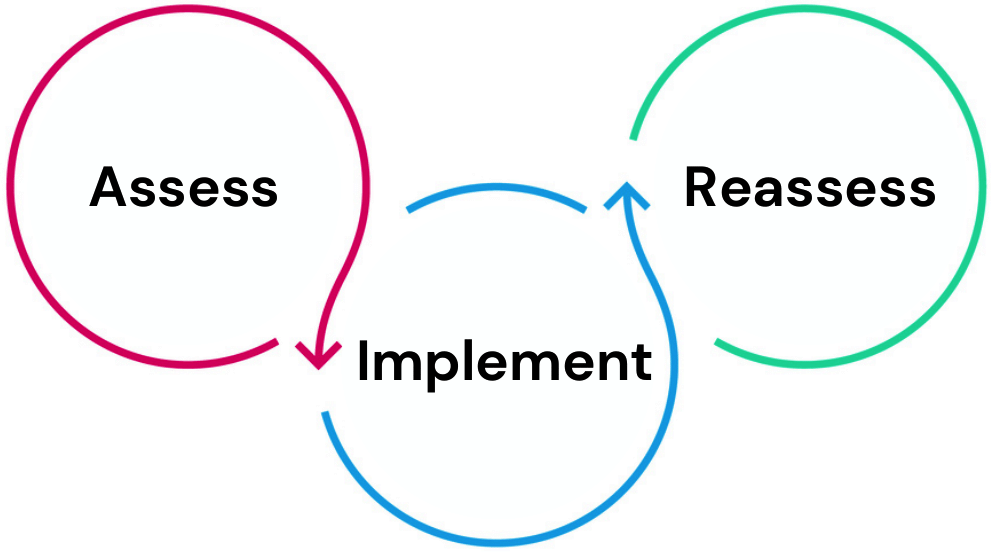Assessment Resources
Assessment Guidance from OTEAR
At OTEAR, we support faculty and staff in enhancing teaching through effective evaluation methods and assessment strategies. Here you will find a variety of resources, tools, and best practices to help you design, implement, and improve assessment methods. If you have questions and would like to speak with a member of the OTEAR staff, please email us at otear@rutgers.edu.
Overview of Assessment
Assessment is the foundation for understanding the student learning experience. It is an iterative process that involves collecting evidence of students’ success in a course or program through measurements of their ability to achieve particular learning goals. A comprehensive assessment plan gives us an opportunity to collect data that can be used to refine teaching methods and ensure that our programs remain rigorous and aligned with industry standards.

The first step in creating an effective assessment plan is to determine what your student’s learning goals and objectives will be. It is also important to define what success in each of these areas will look like and what methods can be used to measure them. This could include direct assessment methods, such as written assignments and exams, or indirect methods, like course surveys. The data collected throughout this process can be used to identify areas where students may be struggling. Instructors and departments are then able to pinpoint gaps in student learning and apply targeted strategies to improve their performance. After implementing new strategies, the course or program should be reassessed to track the difference in the originally identified areas. This final step in the assessment process is referred to as “closing the loop” (Barkley & Major, 2016). Following an assessment plan that is cyclical and based on continuous improvement creates a learning environment that is responsive to student’s needs and a curriculum that aligns with the university’s mission.
Assessment is also a key component in overall program evaluation and institutional effectiveness. It gives departments and universities the tools to make data-informed decisions when looking to make improvements to programs. This data is also essential for demonstrating program quality to accrediting bodies, potential students, and other stakeholders. University Academic Affairs leads the framework for continuous improvement and academic program reviews.
Key Steps of the Assessment Cycle
Resources Available through the Rutgers University Libraries
- Anderson, L. W., Krathwohl, D. R., & Bloom, B. S. (2001). A taxonomy for learning, teaching, and assessing : a revision of Bloom’s taxonomy of educational objectives. Longman.
- Banta, T. W., & Palomba, C. A. (2014). Assessment essentials: planning, implementing, and improving assessment in higher education (Second edition.). Jossey-Bass.
- Barkley, E. F., & Major, C. H. (2016). Learning assessment techniques : a handbook for college faculty (First edition.). Jossey-Bass, A Wiley Brand.
- Brookhart, S. M. (2004). Assessment theory for college classrooms. New Directions for Teaching and Learning, 2004(100), 5–14.
- Hanson, J. M., & Florestano, M. (2020). Classroom Assessment Techniques: A Critical Component for Effective Instruction. New Directions for Teaching and Learning, 2020(164), 49–56.
- Harrison, J. M., & Williams, V. H. (2023). A Guide to Curriculum Mapping : Creating a Collaborative, Transformative, and Learner-Centered Curriculum.
- Mastrokoukou, S., Kaliris, A., Donche, V., Chauliac, M., Karagiannopoulou, E., Christodoulides, P., & Longobardi, C. (2022). Rediscovering Teaching in University: A Scoping Review of Teacher Effectiveness in Higher Education. Frontiers in Education, 7.
- Seifert, T., & Feliks, O. (2019). Online self-assessment and peer-assessment as a tool to enhance student-teachers’ assessment skills. Assessment and Evaluation in Higher Education, 44(2), 169–185.
- Suskie, L. A. (2018). Assessing student learning : a common sense guide (Third edition.). Jossey-Bass.
- Walvoord, B. E. F., & Anderson, V. J. (2010). Effective grading : a tool for learning and assessment in college (Second edition.). Jossey-Bass.
Other Assessment Resources at Rutgers
- University Academic Affairs – Continuous Improvement in Academic Affairs
- Division of Student Affairs-New Brunswick – Assessment Cycle
- School of Arts and Sciences Office of Undergraduate Education – Assessment Resources
- Rutgers Digital Classroom Services – Student Assessment
- Rutgers Cooperative Extension – Program Evaluation Resources
Suggested Reading

- Rutgers University is accredited by the Middle States Commission on Higher Education (MSCHE). A complete list of the standards required for affiliation is available.
- National Institute for Learning Outcomes Assessment New to Assessment Guide
- Carnegie Mellon University – Why should assessments, learning objectives, and instructional strategies be aligned?
- American Library Association’s Examples of Direct and Indirect Measures for Assessment
- Jankowski, N. A., Timmer, J. D., Kinzie, J., & Kuh, G. D. (2018, January). Assessment that matters: Trending toward practices that document authentic student learning. Urbana, IL: University of Illinois and Indiana University, National Institute for Learning Outcomes Assessment (NILOA).
External Resources
References
Barkley, E. F., & Major, C. H. (2016). Learning assessment techniques : a handbook for college faculty (First edition., Chapter 6). Jossey-Bass, A Wiley Brand.
Conzemius, A., & Morganti-Fisher, T. (2012). More than a SMART goal : staying focused on student learning. Solution Tree Press.

